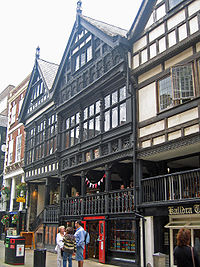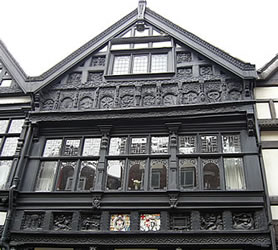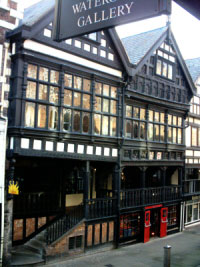Bishop Lloyd's House
Bishop Lloyd 's House or Bishop Lloyd 's Palace is the house with the address 41 Watergate Street, and 51/53 Watergate Row, Chester, Cheshire, England. The building is classified as Grade I and was judged by Nikolaus Pevsner as " perhaps the best " House Chesters.
The house is built on two stone-vaulted cellar dating back to the Middle Ages with overlying truss construction. The first floor includes a section of the Chester Rows. The house is now used by retail stores and the head office of the Chester Civic Trust.
History
The house has its origin in two urban houses on medieval vaults. These two houses were rebuilt in the 17th century into one. The converted house broke with the medieval tradition that the main living room was a large hall on the ground floor; Instead, the main residence of its inhabitants now lay in two elegant rooms in the floor above. The house was owned by Lloyd George, who was from 1605 to 1615 Bishop of Chester. In the 19th century it was run down, and the carvings on its front page were hidden under plaster. The house was now divided into several apartments and was run down. In the 1890s, the former condition of the house by Thomas Lockwood has been restored to a large extent; the current appearance of both the facade and the interior of the building is largely based on its renovation. Lockwood was the eastern part of the two former houses a new facade to make it align the western and added a staircase that led from the east of the road to the ground floor. He positioned the new post, which bare the structure above the ground floor and replaced the Aufschiebfenster 18th century mullioned windows. A further restoration was carried out between 1974 and 1977.
Architecture
Exterior
The building appears visually as two buildings, each of which has a gable and three floors and one attic in the gable. On the street level, the left (eastern ) House a stone staircase with wrought iron railing. At the level of the ground floor there is a eicherner handrail that terminates a balustrade, behind which there is a store front is located. The floor above is supported by projections, are carved into the giant beasts and an owl; more lighter corbels in the form of figures. On the outside are located between the transom above the ground floor and the windows above ten square wooden boards. The windows are divided by Jacobean style carved oak pilasters into three bays. There is a plastered surface above the windows. In the attic the three sash windows is surrounded by other wooden panels. The Verge have carved cornices, which are separated from each a decorated pole in between.
On the ground floor of the western part of the house, a store is having a centrally disposed entrance. On each side of it are two pillars and an arched window with eighteen wheels. In eight are set back provided with carvings wooden panels. The middle two show the royal arms of James I with an inscription and the coat of arms of the Diocese of Sodor and Man ( George Lloyd was Bishop of Sodor and Man, before he became bishop of Chester ) and the year 1615th links which show three wooden panels carved representations of Adam and Eve, Cain and Abel and Abraham and Isaac. Two of the three wooden panels on the other side show biblical scenes.
On the first floor are grouped four Eichenpilaster the windows in three bays, each with two windows with mullions and a fighter windows, a total of 18 windows. Above the windows runs a carved transom and about ten wooden panels show carvings of heraldic monsters. In each of the two attics is a window with three panes, which lies between three wooden panels carved with further representations on both sides. Above the windows are installed three undecorated wooden panels. Also in the attic, the verges are carved and separated by a post.
Interior
The two vaulted cellars have broken walls of red sandstone, the barrel vault were probably added in the 18th century. From the ground floor to the third floor a staircase leads in the style of Chinese Chippendale. In the upper floor there are two rooms. The larger has a stucco ceiling from the 17th century and a large open fireplace; it is believed that this was brought here from the palace of the bishop at the Abbey Square after the palace was damaged in the English Civil War. Even the smaller room has a stucco ceiling, but which is less decorated than in the other room. Among the decorative elements include Tudor roses, horses, and a starfish. On a frieze that runs around the room, sea monsters are presented. The fireplace in this room is smaller. The mantelpiece depicts a Cupid riding a lion.
Presence
The house is open to visitors to see it. Two large rooms in it are rented to event purposes. The administration of the Chester Civic Trust has their headquarters in the building










